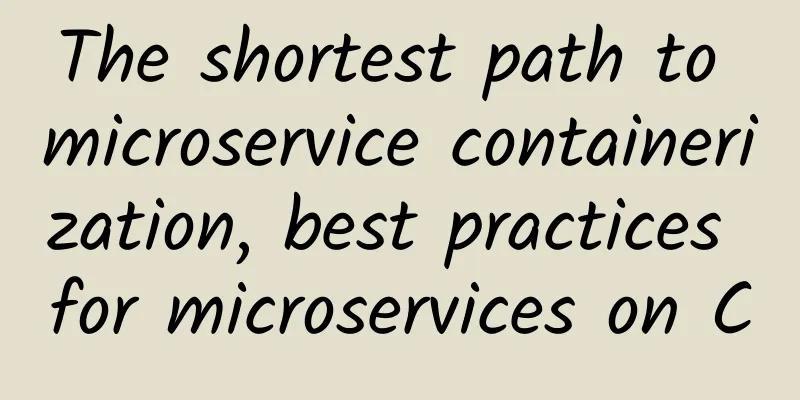The shortest path to microservice containerization, best practices for microservices on C

|
Preface Microservices, as a more flexible, reliable and open architecture, have developed rapidly in recent years. The combination with container technology can easily realize DevOps after microservices. More and more enterprises are seeking to implement microservice containers to better migrate enterprise applications to the cloud. However, due to the learning curve of K8s itself, the complexity of operation and maintenance, service registration and discovery adapted to microservices, version management, grayscale strategy, existing session processing, etc., these customers are discouraged and cannot get it. Alibaba Cloud Serverless Application Engine (SAE) was born in this context. The original intention was to allow customers to enjoy the complete experience of microservices + K8s + Serverless without changing any code or application deployment methods, and to use it out of the box without maintenance. The underlying layer is based on a unified K8s base, which helps users shield IaaS and K8s cluster operation and maintenance, and WAR/JAR/PHP zip packages can be directly deployed without containerization transformation. At the application layer, it provides users with full-stack capabilities, focusing on application management and microservice governance. It is also well integrated in terms of developer tools/SaaS. It can be said that SAE covers the complete scenario of cloud application. SAE is deeply integrated with MSE, and its microservice governance capabilities are leading in the industry SAE is deeply integrated with the Microservice Engine (MSE), and has productized the best practices of microservices that Alibaba has cultivated for more than ten years and has withstood the test of Double 11. On the basis of open source Spring Cloud/Dubbo, it provides more free advanced governance capabilities. For example, the microservice canary/grayscale traffic capability allows the application to accurately grayscale based on various dimensions such as headers/cookies when releasing a new version, and control the minimum explosion radius; the lossless offline and lossless online capabilities of microservices can actively refresh the service list and actively notify through the agent mounted in the SAE application during the Provider upgrade process, and the Consumer will not have a call error. During the service startup process, traffic is smooth and stable regardless of release/capacity expansion. There is also a killer full-link grayscale capability that can achieve cascade traffic grayscale from the seventh-layer inlet traffic to a series of back-end microservices, greatly reducing the cost of building multiple environments for customers and improving the grayscale effect. SAE breaks through Java cold start bottleneck and speeds up by 40% The slow efficiency of Java cold start has been a problem that has plagued developers for many years. Loading many classes and large dependency packages will seriously slow down efficiency. In addition to image acceleration and image preheating efficiency optimization, SAE is also striving to create the ultimate Java application startup efficiency: based on Alibaba Dragonwell 11 enhanced AppCDS startup acceleration technology, the cache generated during the first startup of the application is saved, and the application is started directly from the cache later. Compared with the standard OpenJDK, the cold start time-consuming scenario is improved by 40%, greatly improving the application startup and elasticity efficiency. This technology has been widely used in the group's production business and has received frequent praise from most corporate users. SAE Industry's First Hybrid Elastic Strategy SAE provides the industry's richest elasticity indicators and the most flexible elasticity strategies. Different scenarios use different elasticity strategies. In addition to the cpu/mem provided by the K8s standard, SAE supports new application monitoring indicators such as QPS, RT, TCP connection number, etc., which are more accurate based on business. In addition to scheduled elasticity and automatic elasticity of monitoring indicators, SAE supports hybrid elasticity strategies, which solves the pain point that scheduled elasticity and monitoring elasticity are mutually exclusive and cannot be enabled at the same time in industries such as online education, interactive entertainment, and cultural media. After manual intervention and expansion, the system can also restore automatic elasticity capabilities. SAE provides high-availability solutions for big promotions Serverless Application Engine (SAE) is particularly suitable for industries with sudden traffic bursts, such as e-commerce, new retail, interactive entertainment, online education, catering, travel, and cultural media. It can achieve precise capacity + extreme elasticity + flow control and degradation. |
<<: How does user-mode Tcpdump capture kernel network packets?
>>: Flink 1.14 New Features Preview
Recommend
LisaHost newly launches Hong Kong native IP triple-network CMI backhaul, streaming media unlocks large bandwidth starting from 88 yuan/month
Lisahost has launched a new Hong Kong ISP-type na...
How many optical modules does a GPU need?
1. Network card model There are mainly two types ...
F5's next-generation cloud-native application delivery platform, rSeries, helps enterprises win in the future
Amid the global digitalization, the IT industry i...
The mobile phone number card market is too difficult to operate. Why is it so difficult? What should we do?
Yesterday, I was chatting with a friend who works...
GSA: Global 5G user numbers doubled in Q2, LTE market to decline from 2023
Nearly 800 million of these LTE subscriptions wer...
A detailed study of the IPv6 address structure
IPv6 stands for Internet Protocol Version 6, whic...
From the war of phone bills to the war of traffic, the three major operators are launching a land grab movement again
Among all traditional industries in China, there ...
HostKvm: Russia CN2 bandwidth upgrade, Russia/Hong Kong high-defense limited 50% discount is in progress
HostKvm is a foreign VPS service provider founded...
Do you know how to use VLAN division using network layer protocol?
VLAN (Virtual Local Area Network) is a data excha...
edgeNAT Mid-Autumn Festival/National Day Promotion: VPS monthly payment 30% off, annual payment 40% off, US/Hong Kong/Korea VPS monthly payment starts from 42 yuan
edgeNAT sent a promotional plan for this year'...
5G new call concepts and key technologies
Labs Guide The pursuit of communication technolog...
EBS Lens, a powerful tool for block storage monitoring and service stress testing and tuning, is released
EBS Monitoring Status Block storage is a block de...
Sharktech: $99/month-2*E5-2670V2/32GB/500G SSD/1Gbps unlimited traffic/Los Angeles high defense
Sharktech cancelled the lowest-priced $59/month L...
[11.11] Summary information: VPS-BID/Journey Cloud/Smart Trade Cloud/A400/Themebetter
The annual Double Eleven e-commerce promotion has...
Programmers learn network hubs and switches
From the perspective of network implementation, n...









